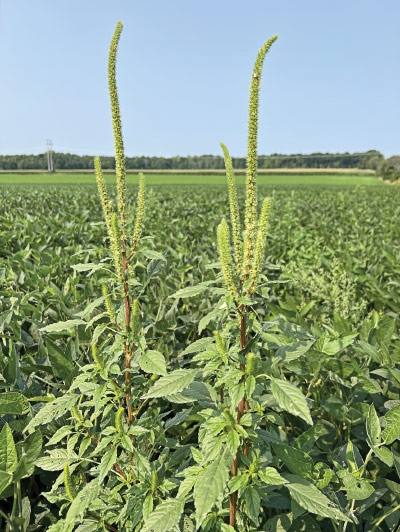Herbicide-Resistant Weeds in the Northeast: An Urgent Call for Integrated Weed Management
![Waterhemp [Amaranthus tuberculatus (Moq.) Sauer]](/sites/neipm/assets/Image/Insights/Waterhemp.jpg) |
|
Waterhemp [Amaranthus tuberculatus (Moq.) Sauer]. Photo: Vipan Kumar. |
By Preetaman Bajwa, Vipan Kumar, and Antonio DiTommaso – Soil and Crop Sciences Section, School of Integrative Plant Science, Cornell University
Weeds are among the most persistent and damaging pests in agricultural systems that compete with crops for essential resources such as light, water, space, and nutrients. Uncontrolled weed infestations pose a major threat to sustainable agricultural production since they can cause significant yield losses and increased production costs. In the United States, weeds have the potential to reduce annual corn and soybean yields by 50 percent and 37 percent, respectively. The rapid spread of herbicide-resistant weed populations during the last decade has brought additional challenges to weed management. This situation has highlighted that reliance on herbicides alone is no longer a sustainable long-term strategy for managing weeds.
Herbicide resistance occurs when a weed population develops the ability to survive herbicide applications that previously controlled it. The primary cause of resistance is repeated application of the same herbicide or herbicide mode of action, which applies strong selection pressure on weed populations. Over time, resistant individuals survive and reproduce, leading to a resistant population. The use of herbicides is a key tool for managing weeds in field crops as evident by the fact that 96 percent of U.S. corn and soybean acreage receives herbicide applications annually. The overreliance of herbicides in field crops has been in part due to the introduction of herbicide-resistant crop traits (e.g., Roundup Ready crops), which has facilitated the use of broad-spectrum products like glyphosate (Roundup PowerMax® or similar brands). Prior to the introduction of glyphosate-resistant crops in 1996, farmers used a range of preemergence (PRE) and selective postemergence (POST) herbicides with distinct modes of action to manage weeds. This overreliance on a single or relatively few herbicide modes of action has led to a substantial increase in the number of herbicide-resistant weed populations. Globally, there are over 534 documented unique cases of herbicide-resistant weed populations, involving 273 weed species across 75 countries (www.weedscience.org). In the United States alone, over 160 herbicide-resistant weed populations have been confirmed. In the Northeast, particularly in New York State, herbicide resistance among weed populations is becoming a serious and growing concern.
In New York State, common lambsquarters (Chenopodium album L.), common ragweed (Ambrosia artemisiifolia L.), and common groundsel (Senecio vulgaris L.) populations have confirmed resistance to atrazine (a major corn herbicide). Additionally, horseweed [Conyza canadensis (L.) Cronq.] populations from orchards have shown resistance to paraquat, and current research at Cornell University suggests that horseweed populations in soybeans are potentially resistant to glyphosate and chlorimuron-ethyl + thifensulfuron-methyl (Synchrony® XP). Preliminary research at Cornell has also identified a few annual ryegrass (Lolium multiflorum) populations from New York wheat fields with high level resistance to glyphosate. Most recently, two highly problematic pigweeds from the Midwest and southeastern United States, Palmer amaranth (Amaranthus palmeri S. Watson) and waterhemp [Amaranthus tuberculatus (Moq.) Sauer] have also been found in the Northeast, including New York State. Since first identified in 2014, waterhemp has rapidly spread to 23 counties in New York State. Both waterhemp and Palmer amaranth populations in New York State have been confirmed resistant to glyphosate. In addition, some of these selected waterhemp and Palmer amaranth populations have also shown multiple resistance to atrazine, mesotrione, and chlorimuron-ethyl + thifensulfuron-methyl. These recently established herbicide-resistant pigweeds are not only a serious threat to corn and soybean production but also to various vegetables and specialty crops in the rotation. These new weeds to the region can cause substantial crop yield losses and increase the need for costly management strategies.
Integrated Weed Management
 |
|
Palmer amaranth (Amaranthus palmeri S. Watson). Photo: Vipan Kumar. |
All these recent reports of herbicide-resistant weed populations in the northeastern region of the United States highlight the urgent need to adopt an Integrated Weed Management (IWM) approach that combines multiple control tactics to manage these weed populations. The foundational concept of IWM adoption aims to reduce selection pressure from any one control method, thereby preserving the effectiveness of existing herbicides while improving long-term weed suppression. Some of the IWM tools currently being investigated in New York include:
- Cultural practices such as narrow row spacing and crop rotation to disrupt weed life cycles and increase crop competitiveness.
- Cover cropping, particularly planting cereal rye, which provides early-season weed suppression through shading and allelopathy.
- Mechanical tools, including inter-row mowing and electric weeders, which target weeds that escape chemical control.
- Precision sprayers and laser weeders that target site-specific weed control in high value specialty crops.
- Seed impact mills, mounted on commercial combines that destroy weed seeds at harvest and help prevent seedbank replenishment.
- Diversified herbicide programs, including rotating herbicide modes of action and applying effective PRE herbicides with residual activity.
While many of these strategies are being assessed at Cornell by colleagues, Vipan Kumar, Lynn Sosnoskie, Matt Ryan, and Bryan Brown, interest from farmers is increasing as awareness of herbicide resistance grows. For example, northeastern U.S. states have among the highest rates of cover crop adoption in the nation. Between 2012 and 2017, cover crop adoption (excluding alfalfa) increased by 24 percent in Maryland to 115 percent in Vermont. By 2017, cover crops were adopted on 32.6 percent of cropland in Maryland, 16.9 percent in Pennsylvania, 10.3 percent in Vermont, and 9.2 percent in New York, exceeding the national average of 5.1 percent. Despite these gains, the adoption of newer non-chemical tools such as seed impact mills and electric weeders remains limited in the Northeast. This is partly due to a lack of weed-specific efficacy knowledge or technical know-how, but likely to the relatively high upfront costs for this equipment. For example, at present, there are only 50 farms in the country that have seed impact mills, whose cost is around $75,000. Similarly, the cost of electric weeders ranges from $78,000 to $90,000, making them a substantial investment. It is hoped that costs for these pieces of equipment will decrease in the future with advancement in technology and competition among different manufacturers.
Although herbicides are often viewed by growers as more convenient, requiring less time and management compared with alternative non-chemical options, the ever-increasing threat of herbicide-resistant weeds in the Northeast will necessitate the use of alternate strategies for their management. Relying entirely on herbicides will possibly be no longer a viable approach because weeds such as Palmer amaranth, waterhemp, horseweed, and annual ryegrass continue to spread and evolve resistance to additional herbicides. IWM provides an effective and flexible approach that combines cultural, mechanical, and chemical tactics to manage weeds more sustainably. Many IWM practices are now moving from experimental research plots to actual farms thanks to researcher and outreach educator efforts and greater farmer engagement. Continued collaboration between these groups is essential for increasing the adoption of these practices and developing regionally adapted solutions. The key takeaway is that a diversified weed management approach based on regional conditions and cropping systems is essential for preserving the efficacy of current herbicides, minimizing resistance development, and maintaining long-term agricultural productivity and profitability of farmers in the Northeast.
 |
Antonio DiTommaso
Antonio DiTommaso, Professor, School of Plant Science, Cornell University, received the Outstanding Achievements in Integrated Pest Management Award from the Northeastern IPM Center in 2025. The annual award, launched in 2019, recognizes individuals or organizations whose work on IPM in the Northeast deserves special recognition.
More details can be found at neipmc.org/go/ApbM.
